Your browser does not fully support modern features. Please upgrade for a smoother experience.
Please note this is an old version of this entry, which may differ significantly from the current revision.
Subjects:
Materials Science, Paper & Wood
Bark-based biorefineries are estimated to become a trending topic in the coming years, particularly with their adsorbent applications and antioxidant production. While the potential benefits of bark-based biorefineries are well-recognized, it is not known how to develop a bark-based biorefinery considering different unit operations and the potential end products.
- biomass
- biofuels
- extractives
- fractionation
1. Introduction
Bark is defined in plant anatomy as the tissues outside the vascular cambium that externally cover the stem and branches [1,2]. Tree barks are heterogeneous complex solid materials, and they are one of the most important forest by-products available in the field or in the wood-processing industries, potentially reaching an annual amount as high as 400 million cubic meters worldwide [3,4]. The majority of produced bark is not valorized as a resource for value-added products, but rather is disposed of as a waste stream or burned at domestic scale. Only a few barks are converted into value-added products, such as that of the cork oak, where the cork in the outer bark is harvested periodically to produce cork products, namely cork stoppers for the wine industry, valued worldwide [5]. Cork is also used in a number of other applications, including insulation, adsorbents, composites, fillers, cement-replacement materials, etc. [5,6,7,8]. Other important industrial barks include birch bark, which is a source of bioactive triterpenoid extractives such as betulin [9], as well as a number of oak and chestnut barks that are utilized for tannin extraction [10]. In former times, willow and poplar barks were extracted to produce salicylates, which are precursors of aspirin [11], which is currently produced from sodium phenolate, a petroleum-based benzene, and CO2 using the Kolbe–Schmitt process [12] following acetylation with acetic anhydride. The barks of oaks, chestnut, pines, and birch, among other species, are currently being analyzed to produce chemicals and materials. However, many other unused or less known tree barks may have potential economic benefits. According to the latest estimation, probably less than 100 of the approximately 73,000 different tree species on Earth [13] are currently industrially used, and they are mostly by-products of high-value timber production [3].
The biorefineries and circular bioeconomy concepts were developed to reduce waste, produce sustainable products, and increase the overall efficiency and economy of biomass processing [14,15]. The overall aim is to use biomass feedstocks to produce chemicals, energy and materials, as is the case in conventional petroleum refineries [16]. Barks are considered potential resources to produce sustainable and biodegradable products in a biorefinery approach [17,18,19,20,21]. In order to develop efficient bark-based biorefineries, it is important to characterize the raw material and envisage the specific potential conversion paths. The chemical composition of bark is among the most important parameters for indicating the possible conversion paths, because it shows the content and composition of chemical fractions that will be available during bark conversion, namely ash, extractives, lignin, polysaccharides, and suberin.
Slow pyrolysis is considered the key thermochemical process for converting bark into energy products, because it increases the efficiency of fuel applications and also produces functional biochars that may be used as solid amendment, adsorbent, etc. [3]. The combustion of bark does not increase the net CO2 release and releases less SOx emissions into the atmosphere than coal because bark is considered carbon-neutral and contains much less sulfur, thereby contributing less to greenhouse gas emissions compared with coal [10]. Emerging technologies such as biomass gasification can further reduce CO2 emissions if bark is used as fuel [22]. To increase gasification efficiency, barks may be subject to a previous pyrolysis process such as torrefaction [23], slow pyrolysis [24], or hydrothermal carbonization [25].
The extraction of bark may also be an essential step in biorefinery development, since barks contain many more extractives than wood and other lignocellulosic materials [26]. Bark extracts, often present in substantial amounts and with an outstanding chemical diversity, may therefore be considered for a large range of applications depending on extract yield and composition. Thus, extraction plays an important role in the valorization of bark, and the production of chemicals is an important step in bark-based biorefineries.
While barks are potentially important resources for biorefineries, their systematic conversion through cascade processing encompassing different conversion routes has not been previously analyzed, and the existing studies concentrate usually on a single conversion process. However, a previous study has shown that the conversion efficiency of spruce bark was significantly improved by using an integrated hot water extraction, pyrolysis, and anaerobic digestion process [27]. A successful bark-based biorefinery will therefore require the evaluation of different conversion processes. To achieve this objective, the chemical composition, and particularly the extract profiles, of different barks must be known.
2. Tree Barks and Biorefinery Research
2.1. Trends in Bark-Based Biorefineries
The first step in the prospective design of a biorefinery is to evaluate the previous studies and trends on the conversion pathways for the target biomass feedstock. A search in the Web of Science (WOS) on the number of publications and research keywords about the lignocellulosic biomass in a biorefinery context is a preliminary phase and has been a common approach in many studies.
It is difficult to estimate the number of studies targeting bark biorefinery by using only the publication titles, because not all have “biorefinery” in the title. Therefore, the screening for biorefinery studies on barks was conducted using the abstract keywords of “bark” and “waste”, since most biorefinery studies are performed with waste materials. The results show that the number of publications on barks has steadily increased, starting from 25 and reaching 92 between 2010 and 2022 (Figure 1). It is therefore reasonable to expect a higher number of publications on bark conversion in the near future. Therefore, to estimate future trends, a forecast was performed (Figure 1). The forecast indicates that the number of bark-based biorefinery studies will most likely increase, and reach between 173 to 208 by 2035, with a 0.95 confidence level.
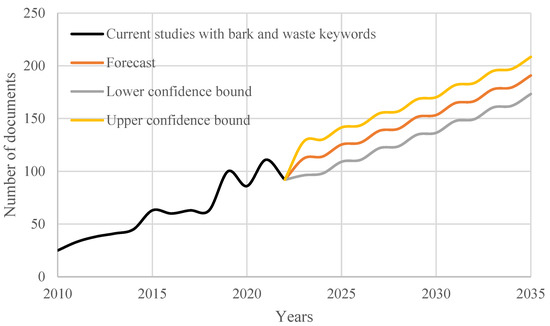
Figure 1. Number of publications in Web of Science using the keywords “bark and waste” in abstracts between 2010 and 2022, and the prognosis of future studies until 2035 with a 0.95 confidence level.
In a second step, using the same approach, abstracts were searched for the terms bark, extraction, and pyrolysis, which resulted in only 28 research items. Considering the low number of co-occurring studies, research titles including bark crossed with pyrolysis or extraction were searched for an extended time frame (1945–2023) and co-occurrence maps were created [28]. These maps show an overview of the studied topics on “bark and pyrolysis” or on “bark and extraction” (Figure 2). The different co-occurring research topics were analyzed, as shown by the different color clusters, and the most-studied topics are represented with larger circles. These maps indicate that studies on bark extraction are more common (310 research items) than on bark pyrolysis (91 research items), with antioxidant production and adsorption applications making up the principal research clusters.

Figure 2. Co-occurrence map of publications with the titles “bark and extraction” on the left, and “bark and pyrolysis” on the right in WOS between 1945 and 2023.
Based on the results of the co-occurrence maps, we deduced that antioxidant production and adsorption applications from barks will be the most important topics in the near future. To estimate future trends, the same forecasting as carried out in Figure 1 was performed, and Figure 3 was created, which shows estimations of the possible development of these topics in the coming years.
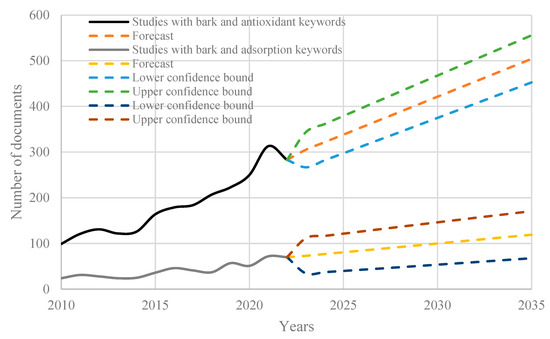
Figure 3. Number of publications in Web of Science using the keywords “bark and adsorption” and “bark and antioxidant” in abstracts between 2010 and 2022.
2.2. Current Bark-Based Biorefinery Applications
The previous section gives information on the development and direction of bark-based biorefineries in the near future. Currently, the application of an integrated biorefinery concept for bark is in its infancy, but recent studies show that its use may be increasing. Therefore, it is important to analyze these works. The bark-based biorefinery studies were performed using barks such as Norway spruce, Scots pine, radiata pine, birch, and aspen, based on a previous screening and evaluation of potentially valuable chemical components including extractives, non-cellulosic polysaccharides (mostly pectin and starch), lignin, cellulose, and suberin [27,29,30,31,32,33,34] (Figure 4, Figure 5, Figure 6, Figure 7, Figure 8, Figure 9 and Figure 10). Interestingly, although almost all of these studies considered extraction as the first step, they did not consider a further refinement of extracts. Acetone, hot water, and supercritical CO2 (scCO2) extractions were tested for the screening of bark extracts [29,31,32]. The polysaccharide-containing hot water extracts of spruce bark showed immunostimulating activity, suggesting that the extraction of barks may be further refined to obtain bioactive compounds [35].
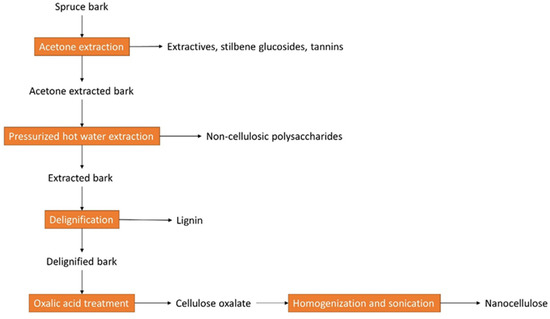
Figure 4. Spruce bark biorefineries.
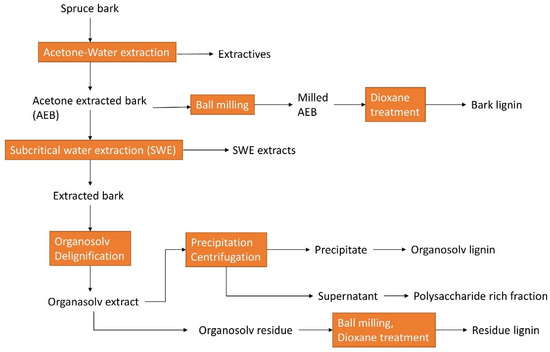
Figure 5. Spruce bark biorefineries.
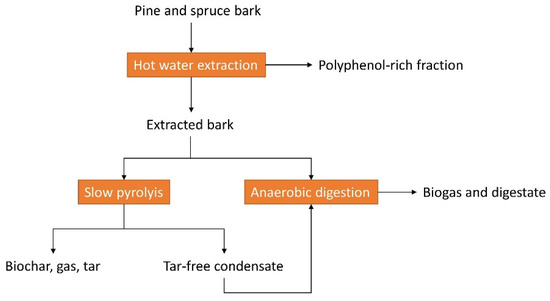
Figure 6. Pine and spruce bark biorefineries.
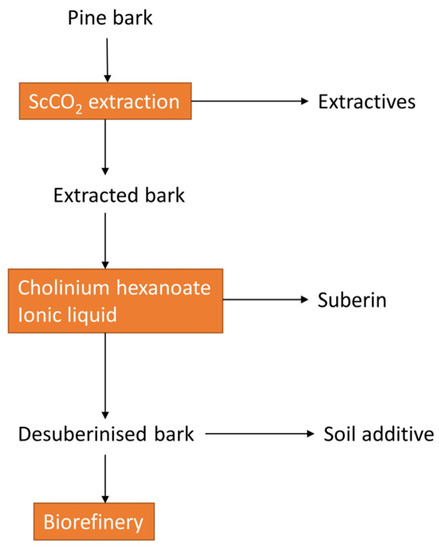
Figure 7. Pine bark biorefineries.

Figure 8. Pine bark biorefineries.
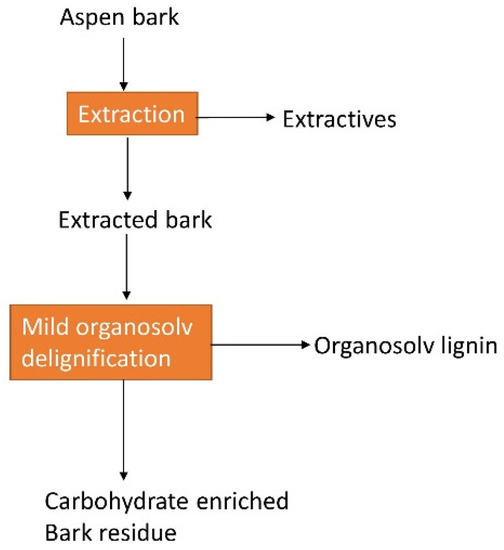
Figure 9. Aspen bark biorefineries.
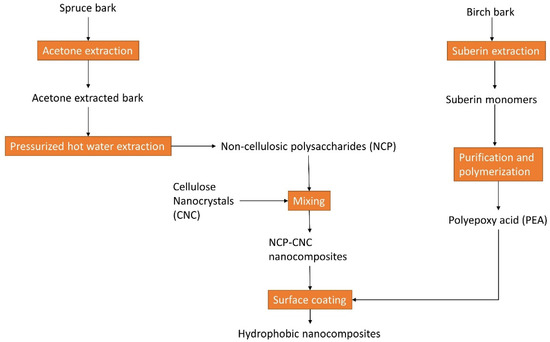
Figure 10. Spruce and birch bark biorefineries.
The non-cellulosic polysaccharides (NCPs), which are rich sources of glucose, arabinose, and galacturonic acids, were obtained from spruce bark with up to 20% yield by using pressurized hot water extraction [36]. The polysaccharide content of barks is lower than that of woods, agricultural wastes, and energy crops [3], but the extraction of NCPs enables the production of functional materials by the addition of other polysaccharide-derived cellulose nanocrystals (CNC) such as NCP/CNC films [20]. The CNCs may be derived from barks [19] or from other lignocellulosic feedstocks [34].
Suberin extraction is another approach in bark biorefineries when the bark has a high content of cork. The application of ionic liquids seems to be a promising method to obtain highly pure suberin [37], which may be used to produce functional materials [31]. Suberin monomers obtained by alkaline hydrolysis may be integrated into biorefineries after purification and polymerization, such as the production of polyepoxy acid [34] as an additive for NCP/CNC films.
The extraction and fractionation of bark lignin through ball milling and organosolv extraction [30] is possibly the most promising approach in bark biorefineries considering the high lignin content of barks. The bark-based lignins are alternative materials to fossil-based materials in the production of polymers and biofuels [30].
The efficiency of bark-based biorefineries may be increased by integrating different extraction, thermal conversion, and biological processes, such as extraction, slow pyrolysis, and anaerobic digestion [27]. The extraction and slow pyrolysis methods seem to be particularly suitable for the conversion of barks in a biorefinery concept, as explained in the next chapters. Biological processes may not be efficient in a bark biorefinery process considering the recalcitrance of the biomass and low polysaccharide content. However, current information is limited and more studies are required to evaluate the performance of biological processes with bark feedstock.
3. Critical Evaluation of Bark-Based Biorefineries
3.1. Screening Barks for Biorefinery
Pyrolysis (slow pyrolysis, torrefaction, and hydrothermal carbonization) and extraction are considered the key conversion routes for bark, given that the technological conditions of pyrolysis processes and the high extractive content of bark favor these two routes. The development of efficient biorefineries requires the screening of barks’ properties, namely moisture content, ash content, chemical composition, higher heating value, extractive yield, and composition.
Moisture content varies greatly between different barks and different positions in the tree, as well as between different seasons [3,154]. High-moisture-containing barks should be considered for the HTC process to avoid drying costs in dry pyrolysis. The ash content of barks is usually at least ten times higher than that of wood of temperate zones, which usually contains less than 1% ash [10,155]. The upper limit of ash content of bark may be considered as 20% [2]. The high ash content of bark may become problematic in thermal conversion because certain ash components such as potassium and calcium may cause slagging and fouling problems [156,157]. The high-ash-containing barks (>3%) should be pretreated with hot water to reduce the ash content if they are targeted for fuel use [158,159]. However, the ash removal from bark after hot water treatment may be insufficient [160] and in this case, the hydrothermal carbonization route should be applied to obtain higher biochar yields and to avoid ash-related problems during dry pyrolysis [161,162].
The macromolecular chemical composition of bark includes polysaccharides, lignin, and suberin. Hardwood and softwood barks may differ in their lignin and holocellulose contents as well as in their suberin content [163]. The chemical composition of different barks was reviewed in a previous article that reported 18–44% polysaccharides, 32–40% lignin, and 2–34% suberin [3]. Compared with wood, bark contains a higher amount of ash and extractives, and a lower amount of polysaccharides [10]. It also contains suberin and polyphenols which are absent in wood [3,10]. The cork-rich barks with high suberin content may be directed to obtain suberin monomers and lipophilic extracts to produce polymers and triterpenoids [141,164,165,166,167,168]. The lignin-rich barks should be considered for the production of biochars with higher char yields or to produce polyols and polyurethanes [169,170,171,172,173,174] or aromatics [175]. Different pretreatments such as organosolvent methods may be applied to increase the conversion efficiency of bark macromolecules such as suberin [176]. Bark polysaccharides may be considered for the production of food delivery packaging because they have a cost advantage as waste materials, they provide adequate strength, and they are biodegradable [177]. The fractionation of the polysaccharide fraction of barks is a complicated task due to the recalcitrance of the biomass and low polysaccharide content, although catalytic fractionation may overcome these problems [27,178].
The heating value of bark is slightly higher than that of wood and ranges between 18.7 MJ/kg and 22.7 MJ/kg [10,179]. Softwood barks generally have higher heating values than hardwood barks [179]. Barks with higher calorific values are potentially better suited for fuel applications. The production of cork pellets with a calorific value of 20 MJ/kg is an example of a fuel use for bark [180]. Fuel pellets produced from softwood barks demonstrated high mechanical durability [181], which is an important parameter in handling and transportation [182].
Extractives of barks may be grouped into hydrophilic compounds, lipophilic compounds, and polyphenols such as condensed tannins. Hydrophilic compounds are the main bark extracts, as shown in the previous section, and have antioxidant and bioactive properties [183]. In the biorefinery, these compounds should be extracted in a first step under low temperatures to avoid thermal decomposition and with a suitable extraction method, considering selectivity, efficiency and environmental impact. The most important lipophilic extracts are terpenes and triterpenoids, which are likely to have therapeutic activities, including anticancer, antimicrobial, and antiviral activities [184,185]. Barks with high amounts of lipophilic extractives such as cork-rich barks should be selected for the production of triterpenoids, while barks containing high amounts of hydrophilic extractives should be selected for phenols to produce antioxidants and aromatic compounds [186,187]. Barks containing high amounts of polyphenols should be selected for the production of tannins [188,189,190].
3.2. Development of a Biorefinery Scheme
A biorefinery scheme for bark-based biorefineries is proposed in Figure 11, taking into account the discussed bark characteristics and screening factors. A total of three conversion loops are determined. The first loop (L1) is the extraction processes, consisting of different extraction methods to target specific extracts. The second loop (L2) is the pyrolysis processes, which consists of HTC, slow pyrolysis, and torrefaction to produce hydrochars, biochars, and fuel pellets. The third loop (L3) is the macromolecular conversion processes, consisting of the depolymerization of the bark structural components. The threshold limits for selecting conversion routes are set at 30% for moisture and at 3% for ash content. A total of nine different biorefinery products are proposed, of which six can be produced by pyrolysis and extraction methods. The transformation of the macro chemical components in bark is beyond the scope of this review and thus only briefly discussed. The proposed biorefinery products (biochars, hydrochars, fuel pellets, simple phenols, triterpenoids, and condensed tannins) suggest that waste barks can be integrated into biorefinery systems to produce chemicals and solid products. The environmental impact of different conversion routes should be analyzed before the implementation of any biorefinery scheme.
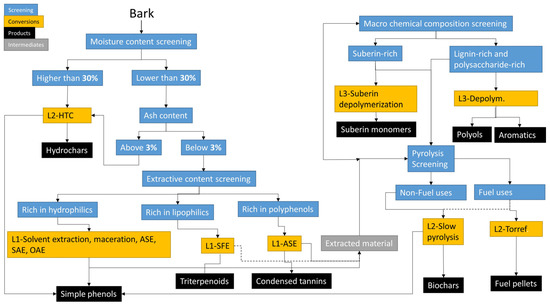
Figure 11. Proposed scheme for bark biorefineries.
The most abundant and versatile bark biorefinery product seems to be simple phenols, which can be obtained by hydrophilic extraction, hydrothermal carbonization, or slow pyrolysis. Simple phenols are platform chemicals that may be used to produce plastics, pharmaceuticals, or other chemicals.
3.3. Current Knowledge Gaps and Future Directions
The results show that bark and biorefinery studies have experienced an increasing trend in recent years, with biorefineries increasingly being directed toward waste materials including bark. However, knowledge gaps exist, and their identification and surmounting are important for developing bark-based biorefineries.
The following knowledge gaps on bark conversion were identified in this work:
-
The number of bark characterization studies is insufficient: only a total of 21 articles investigated the extract composition of different barks.
-
The applied pyrolysis conditions are non-standardized: a total of 13 articles applied different conditions, which complicates the evaluation of the most economic processing conditions.
-
The applied extraction conditions were also variable. Since the extract composition, properties and yield depend on the applied solvent and method, we limited our discussion to cases with similar extraction procedures.
-
Energy balance is an important parameter in the evaluation of different processing paths and the scaling up of biorefinery processes. However, the pyrolysis and extraction conditions, as well as chemical properties, of different barks are highly variable which make the energy balance an unhelpful tool. More research is needed to evaluate the energy balance of different bark conversion processes.
-
There is a lack of studies on the environmental impact of bark valorization.
-
Studies combining different processing routes are insufficient: only Rasi and co-workers (2019) studied a cascade processing method consisting of hot water extraction, pyrolysis, and anaerobic digestion for pine and spruce barks [27].
-
There is a lack of studies investigating the production of bark-based platform chemicals such as simple phenols via pyrolysis or extraction.
Considering these limitations, the following recommendations can be made:
-
More research is needed on the chemical and pyrolysis properties of barks. Possibly fewer than 100 barks have been considered for valorization, which is a very small number regarding the huge potential for bark valorization given the existing number of tree species. Future bark valorization studies should apply standardized methods.
-
The bark valorization studies should consider cascade processing, combining different valorization processes instead of a single process.
-
The environmental impact of the different applied conversion processes is largely unknown, as is their economic evaluation. Energy balances should be provided in bark conversion studies.
-
Different bark extracts should be screened for antioxidant or nutraceutical potential, including pharmacokinetic profiles and drug-like properties.
-
The production of phenolic substances and simple phenols should target extractive-rich barks after chemical screening. Barks may be a source of platform chemicals such as simple phenols, as in earlier studies before their replacement with petroleum-based products. It is therefore necessary to re-consider bark for the production of platform chemicals to be used in the food, fragrance, or pharma industries. Efficient and selective production of these chemicals through extraction, pyrolysis, or depolymerization may open up new possibilities for bark valorization, namely using optimized and environmentally friendly conversion methods and improved catalysts [192].
Bark-based biorefineries require a detailed characterization of barks. In general, barks contain a high amount of extractives and inorganic compounds, a low amount of polysaccharides, and also contain suberin and polyphenols, with the cork-rich barks containing the highest amount of lipophilic extracts, e.g., triterpenoids. Therefore, pyrolysis and extraction methods are proposed for bark-based biorefineries, which should be integrated with macromolecular conversion methods.
This entry is adapted from the peer-reviewed paper 10.3390/en16134848
This entry is offline, you can click here to edit this entry!
